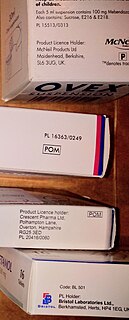Related Research Articles

The Controlled Substances Act (CSA) is the statute establishing federal U.S. drug policy under which the manufacture, importation, possession, use, and distribution of certain substances is regulated. It was passed by the 91st United States Congress as Title II of the Comprehensive Drug Abuse Prevention and Control Act of 1970 and signed into law by President Richard Nixon. The Act also served as the national implementing legislation for the Single Convention on Narcotic Drugs.

A medication is a drug used to diagnose, cure, treat, or prevent disease. Drug therapy (pharmacotherapy) is an important part of the medical field and relies on the science of pharmacology for continual advancement and on pharmacy for appropriate management.

A prescription drug is a pharmaceutical drug that legally requires a medical prescription to be dispensed. In contrast, over-the-counter drugs can be obtained without a prescription. The reason for this difference in substance control is the potential scope of misuse, from drug abuse to practicing medicine without a license and without sufficient education. Different jurisdictions have different definitions of what constitutes a prescription drug.

Opioid use disorder (OUD) is a substance use disorder relating to the use of an opioid. Any such disorder causes significant impairment or distress. Signs of the disorder include a strong desire to use opioids, increased tolerance to opioids, difficulty fulfilling obligations, trouble reducing use, and withdrawal symptoms with discontinuation. Opioid withdrawal symptoms may include nausea, muscle aches, diarrhea, trouble sleeping, agitation, and a low mood. Addiction and dependence are components of a substance use disorder. Complications may include opioid overdose, suicide, HIV/AIDS, hepatitis C, and problems at school, work, or home.
Drug diversion is a medical and legal concept involving the transfer of any legally prescribed controlled substance from the individual for whom it was prescribed to another person for any illicit use. The definition varies slightly among different jurisdictions, but the transfer of a controlled substance alone usually does not constitute a diversion, since certain controlled substances that are prescribed to a child are intended to be administered by an adult, as directed by a medical professional. The term comes from the "diverting" of the drugs from their original licit medical purpose. In some jurisdictions, drug diversion programs are available to first time offenders of diversion drug laws, which "divert" offenders from the criminal justice system to a program of education and rehabilitation.

The Comprehensive Drug Abuse Prevention and Control Act of 1970, Pub.L. 91–513, 84 Stat. 1236, enacted October 27, 1970, is a United States federal law that, with subsequent modifications, requires the pharmaceutical industry to maintain physical security and strict record keeping for certain types of drugs. Controlled substances are divided into five schedules on the basis of their potential for abuse, accepted medical use, and accepted safety under medical supervision. Substances in Schedule I have a high potential for abuse, no accredited medical use, and a lack of accepted safety. From Schedules II to V, substances decrease in potential for abuse. The schedule a substance is placed in determines how it must be controlled. Prescriptions for drugs in all schedules must bear the physician's federal Drug Enforcement Administration (DEA) license number, but some drugs in Schedule V do not require a prescription. State schedules may vary from federal schedules.

Sodium oxybate, sold under the brand name Xyrem among others, is a medication used to treat two symptoms of narcolepsy: sudden muscle weakness and excessive daytime sleepiness. It is used sometimes in France and Italy as an anesthetic given intravenously; it is also used in Italy to treat alcohol addiction and alcohol withdrawal syndrome.
An online pharmacy, internet pharmacy, or mail-order pharmacy is a pharmacy that operates over the Internet and sends orders to customers through mail, shipping companies, or online pharmacy web portal.

The environmental effect of pharmaceuticals and personal care products (PPCPs) is currently being widely investigated. PPCPs include substances used by individuals for personal health or cosmetic reasons and the products used by agribusiness to boost growth or health of livestock. More than twenty million tons of PPCPs are produced every year.

The International Nonproprietary Name Dronabinol, also known as Marinol, Syndros, REDUVO and Adversa, is a trade name for a specific form of tetrahydrocannabinol, sold as an appetite stimulant, antiemetic, and sleep apnea reliever. It is approved by the FDA as safe and effective for HIV/AIDS-induced anorexia and chemotherapy-induced nausea and vomiting only.
The Ohio Automated Rx Reporting System (OARRS) is Ohio's state Prescription Monitoring Program (PMP) and is controlled by the Ohio State Board of Pharmacy. The law permitting the Board of Pharmacy to create the PMP was signed on March 18, 2005, and became effective January 1, 2006. The OARRS program began operation on October 2, 2006. The law is available to read in the Drug Laws of Ohio pages C-50 through C-54. The Ohio State Board of Pharmacy is responsible for collecting and verifying data for prescriptions that the Drug Enforcement Administration (DEA) classifies Schedule II-V as well as carisoprodol and tramadol prescriptions.
In the United States, prescription monitoring programs (PMPs) or prescription drug monitoring programs (PDMPs) are state-run programs which collect and distribute data about the prescription and dispensation of federally controlled substances and, as the individual states deem appropriate, other potentially addictive or abusable prescription drugs. PMPs help to prevent adverse drug-related events through opioid overdoses, drug diversion, and substance abuse by decreasing the amount and/or frequency of opioid prescribing.
Electronic Prescriptions for Controlled Substances (EPCS) was originally a proposal for the DEA to revise its regulations to provide practitioners with the option of writing electronic prescriptions for controlled substances. These regulations would also permit pharmacies to receive, dispense, and archive these electronic prescriptions. These proposed regulations would be an addition to, not a replacement of, the existing rule.

The term Environmental persistent pharmaceutical pollutants (EPPP) was first suggested in the nomination in 2010 of pharmaceuticals and environment as an emerging issue in a Strategic Approach to International Chemicals Management (SAICM) by the International Society of Doctors for the Environment (ISDE). The occurring problems from EPPPs are in parallel explained under environmental impact of pharmaceuticals and personal care products (PPCP). The European Union summarizes pharmaceutical residues with the potential of contamination of water and soil together with other micropollutants under “priority substances”.

Methamphetamine in the United States is regulated under Schedule II of the Controlled Substances Act. It is approved for pharmacological use in the treatment of attention deficit hyperactivity disorder and treatment-resistant obesity, but it is primarily used as a recreational drug. In 2012, 16,000 prescriptions for methamphetamine were filled, approximately 1.2 million Americans reported using it in the past year, and 440,000 reported using the drug in the past month.

A pill mill is an illegal facility that resembles a regular pain clinic, but regularly prescribes painkillers (narcotics) without sufficient medical history, physical examination, diagnosis, medical monitoring, or documentation. Clients of these facilities usually receive prescriptions only against cash. Pill mills contribute to the opioid epidemic in the United States and are the subject of a number of legislative initiatives at the state level.

The opioid epidemic refers to the extensive overuse of opioid medications, both from medical prescriptions and from illegal sources. The epidemic began in the United States in the late 1990s, when opioids were increasingly prescribed for pain management and resulted in a rise in overall opioid use throughout subsequent years.

Drug disposal is the discarding of drugs. Individuals commonly dispose of unused drugs that remain after the end of medical treatment. Health care organizations dispose of drugs on a larger scale for a range of reasons, including having leftover drugs after treating patients and discarding of expired drugs. Failure to properly dispose of drugs creates opportunities for others to take them inappropriately. Inappropriate disposal of drugs can also cause drug pollution.
An unused drug or leftover drug is the medicine which remains after the consumer has quit using it. Individual patients may have leftover medicines at the end of their treatment. Health care organizations may keep larger amounts of drugs as part of providing care to a community, and may have unused drugs for a range of reasons. The unused drugs should be destroyed utterly to eliminate the toxic effects of undisposed drugs on flora and fauna. The improper disposal of unused drugs could be the reason for the contamination of Surface, Ground and Drinking Water. Discharge of unused antibiotics and disinfectants in the sewage system may ruin the aquatic life or contamination of drinking water.

The opioid epidemic, also referred to as the opioid crisis, is the phrase used to describe the overuse, misuse/abuse, and overdose deaths attributed either in part or in whole to the class of drugs opiates/opioids, and the significant medical, social, psychological, and economic consequences of both the medical and the non-medical or recreational use of these medications.
References
- 1 2 "National Prescription Drug Take Back Day". Washington, D.C.: U.S. Drug Enforcement Administration. Retrieved 2021-06-13.
- ↑ "The Dangers of Leftover Meds". Boston, MA: Product Stewardship Institute. Retrieved 2021-06-13.
- ↑ Keegan, Megan (2014-05-01). "Spring Cleaning—In Your Medicine Cabinet". The EPA Blog. Washington, D.C.: U.S. Environmental Protection Agency (EPA).
- ↑ Substance Abuse and Mental Health Services Administration (2009). "2009 national survey on drug use and health" (PDF).
- ↑ Fass, Jennifer (2011). Prescription drug take-back programs. 68. Fort Lauderdale, FL: American Journal of Health-System Pharmacy.
- ↑ United States. Secure and Responsible Drug Disposal Act. Pub.L. 111–273 (text) (pdf) Approved October 12, 2010.